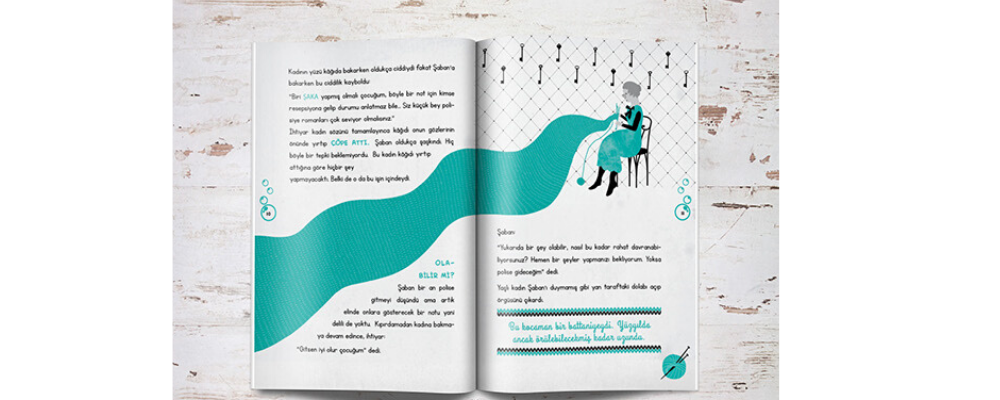In Ayşe Sevim’s series named as “Story Key-maker”, consisting of two books Lift for Strangeness and Time for Dragons, a fantastic story in which the protagonist Şaban’s experience is presented to the reader.
In Ayşe Sevim’s series named as “Story Key-maker”, consisting of two books Lift for Strangeness and Time for Dragons, a fantastic story in which the protagonist Şaban’s experience is presented to the reader. As Şaban was growing up just like other children, his routine life changes suddenly one day with a note which drops out of the sky: “Please help me! I am stuck up here. The person who gets this paper, please save me!” (Sevim 8). With this note Şaban gets into an indefinite and intriguing story. On this occasion, story creates a channel to link the reader to itself.
There are uncertainty and a nervous mood state are on the basis of fantastic fiction. This mood state shall pull the reader into the story and lead the process. The story presents a successful introduction in this context. Pierre-Georges Castex, who moots that fantastic opens a hole in daily life, violates accepted norms and creates fractions and illusion in reality, describes fantastic as “the knot of a person who experiences an extraordinary incident, is shocked and feels reality of a phenomenon and believes feeling its reality despite the objections of mind. As for Todorov, he describes it as “subject’s, who does not flout the laws except for its own laws, experiencing the mood of suspect upon facing an extraordinary incident” (cited in Aslan Ayar 25-6). In accordance with these definitions, Şaban hesitates whether to pursue the note: “Şaban hang on his school backpack’s handles and said: ‘I will go, whoever finds this note would do the same. I will go and call for help.’ Şaban thought he would wonder what happened if he did not get on the lift for the rest of his life.”
At this part, what is possible predominated reality and with the effort to chase the truth, became the emotion leading the book.
The book draws attention with a structure that feeds the fantastic fiction, puts the elderly not to expected but unexpected positions. These are little modules of fictional patterns which are going to direct the story. In Lift for Strangeness witnessing an elderly woman’s serving as the Story Key-maker at the lounge is an extraordinary situation for Şaban. Şaban encounters with the Story Key-maker at a museum in Time for Dragons, and this was also unexpected for him. Key is responsible with unlocking the lock of ruptured relation between past and future. The fact that Story Key-maker is an elderly lady makes sense here. In fantastic works people who guide and lead the protagonist throughout their journey are elderly, wise people. Their advice helps the protagonist to cut the gordian knot.
Fantastic as a literary genre does not only transform outer world but also “first” texts ranging from holy books to folk stories, and by doing so it actually transforms the literature; a narration in fantastic genre is actually has a blood-relation with the first narrations. Mythology and legends are considered to be the founders of fantastic with their astonishing incidents and their characters, geographical weirdness, supernatural narration and stories they tell regarding Earth’s formation. Extraordinary narrations contributed to formation of fantastic together with supernatural tales in which fairies, monsters, boggarts, wizards, giant snakes and gins are seen frequently. (Aslan Ayar 27-8). In this context, the book includes fantastic patterns. The reader may understand that world’s ordinary situations and find their way to tend to question through these patterns by which shifts are conducted. In both books, an anecdote, a biography text, sayings of religious leaders are included as guides for Şaban. In Time for Dragons, Şaban is beamed up to the times of Kürşad Revolt, and there he encounters anecdotes and sayings of Ali (R.A.). Here, the writer composes Islam patterns and Turkish legends and stories. Much as this composition is integrated successfully in The Lift For Strangeness, fantastic phenomenon theme remained in the background in Time for Dragons. Even though fantastic elements are included, religious anecdotes kept ahead and this artificialized fantastic patterns. Patterns in The Lift for Strangeness are composed with objects of modern world. This composition has more sincere and persuasive characteristics than Time for Dragons.
Potkal, horse, lift are the mediums enabling Şaban to travel among times. Potkal is a bottle that a text reporting the status of a ship which had an accident offshore or another incident took place on sea is put in. It is the communication medium of past times. As for the lift, it is a floor carrier for a short time in the modern world. Here two different mechanism are presented to our attentions through objects. Quick course of events in the modern world poses an obstacle for people to understand each other and communicate. Lifts, which popped up in every part of daily life and apartments or plazas, are representations of human beings who live in their own worlds. Potkals are introduced as a communication medium which exist in natural world. Life styles that possibilities bring to, direct human relations. Words stuck in concrete or material turned people’s life to an egocentric perspective. Şaban’s fantastic journey is also based on understanding the past and the future through egocentric lives.
As the fact that this book bears a message can be inferred from expressing the fiction of an entertaining tone, Şaban’s taking lessons from his journeys and the fact that each character represents a principle or moral tendency, these are the leading functions. After all adventures, Şaban goes back to the hotel in order to find whom the note belongs to. He realises that it is himself who threw it. Şaban’s story appeals to understand and get to know himself and there is no end for this: “The door opened for you by the Story Key-maker has not closed yet. You are going to continue your travel. We are going to call you back in a short time.” (Sevim 119).
Bibliography
Aslan Ayar, Pelin. Türkçe Edebiyatta Varla Yok Arası Bir Tür: Fantastik Roman (1876-1960). İstanbul: İletişim
Yayınları, 2015.
Sevim, Ayşe. Hikâye Anahtarcısı 1: Tuhaflıklar Asansörü. İstanbul: Profil Yayınları, 2016.
Sevim, Ayşe. Hikâye Anahtarcısı 2: Ejderhalar Zamanı. İstanbul: Profil Yayınları, 2016.

